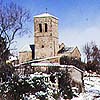

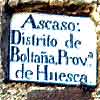
| Valle de Puértolas - Puyarruego |
| Home | Excursions | Puyarruego | Lafortunada | Muriello | Ascaso | Fruits |
 |
 |
 |
|
| Nederlands | The sundials of Ascaso |
| Ascaso is a village
on the hills longing the valley of the Río Ara, the last wild
river in the region. The walk starts from the main road between
Boltaña and Fiscal.
From L'Ainsa take the road to Torla (Ordesa). Soon after Boltaña
you'll find a branch towards Lanava and Sabiñánigo.
In one of the next bends (before the tunels of Balupor) there is
a small parking spot and a bit further the start of the narrow road
leading to Ascaso. |
 |
|
| Ascaso built on a north-south ridge |
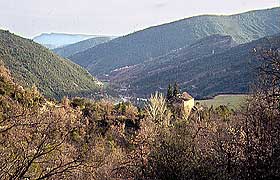 |
Follow the gravel road
and very soon you'll notice the ruines of Santa Maria de Ascaso.
It's a dilapidated house with a collapsed chapel next to it.
Only the outer walls of the house are still upright. All floors are down to one.
The wall facing south bears a huge sundial.
You can enter the garden through a shaky wooden gate with inscription Año 1823 Me Fecit. Bring binoculars with you. The sundial is quite high on the wall and it's probably more comfortable, because of the thornbushes, to study the details from the road. |
||
| Santa Maria de Ascaso Río Ara in the depth |
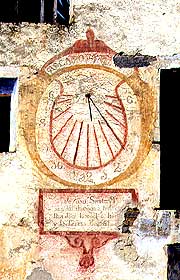 |
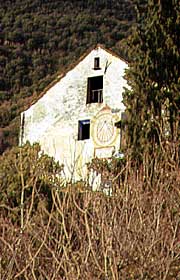 |
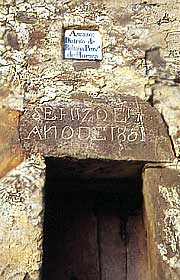 |
|||
| Santa Maria de Ascaso sundial dating from 1890 |
Santa Maria de Ascaso façade with sundial |
The second sundial carries the year 1861 |
| The text below the sundial
is badly faded. Someone should urgently take steps to preserve the wall
and the painting.
This is what I could decipher:
De casa Santa María son los dueños a toda costa Don José Lacort e hijos y la Teresa Beltosta The short black dash is the gnomon; the long black stroke is its shadow, indicating the local time. |
Notice that the gnomon grows from the mouth
of a face with a wealth of hair. The orientation of the gnonom is north-south
and parallel with the Earth's axis. The angle of the rod with the wall
gives the local North latitude.
This kind of sundial is best mounted on a wall facing exactly South and then can give a maximum of 12 hours. A deviation from the South lowers the usefull time. Thin strokes are drown between the thick red hour-lines. They indicate each quarter of an hour. I wonder if this dial is drawn precisely enough for them to be of real use. |
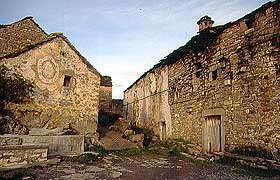 |
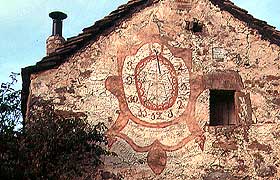 |
||
| Plaza with fountain and sundial | Sundial at the village square |
| If you continue your walk, you will eventually reach the village center of Ascaso. The second sundial is directly at your left on the wall above the fountain. Here also, the shadow casting gnomon grows from a face. The plate features four hours less than in Santa María. The inner circle is drawn rather careless and hiding the lines for the earliest and latest hours of the day. This was probably not so originally. Maintenance was probably done by people lacking knowledge about sundials. | Here comes the text:
(When the Sun is on my face) acércate paso a paso (then come closer step by step) y sabrás la hora que es (and you'll know how late it is) en este reló de Ascaso (on this watch of Ascaso) The stone of the window next to the sundial is telling us Se hizo el año de 1831. |
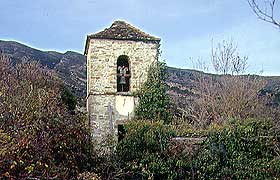 |
It's a good idea
to walk through the village to the south and a bit further on the old path.
Take a look at the old church. I think that the tower, in earlier times,
also featured a sundial. If you continue your walk to the ridge you'll enjoy a splendid sight over the valley of the Río Ara. La Ronda de Boltaña (a very popular group in this region) names Ascaso (with sundials) and several other villages in their song El viento rondador. Website: www.rondadors.com. In Spanish. |
||
| Church with a third lost sundial ? |
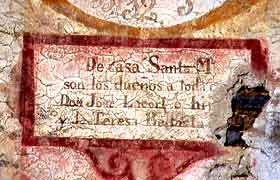 |
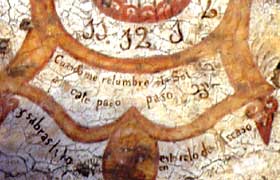 |
||
| The text in Santa Maria Notice the guiding lines. |
Text of the sundial in the village Guidelines were considered not necessary. |